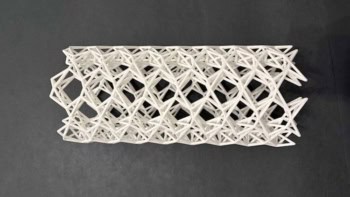
Networks of rotating bearings can better recover from perturbations to their harmonious motion if the masses of the individual discs are proportional to their radii – this is the finding of a team of physicists based in Switzerland and Brazil. Although surprising, the result hints at how to construct more robust mechanical bearings, as well as offering fresh insight into the synchronization of complex oscillating systems such as electrical networks and the Internet.
Bearings are the small workhorses at the heart of many mechanical devices used today. The secret to their success is that they reduce the friction between two surfaces that need to slide past one another by offering them a chance to roll. Think of the Ancient Egyptians transporting gigantic slabs of rock on beds of rolling logs – would the pyramids ever have been realized if the rocks had been shunted along the ground unaided? A more sophisticated example is the wheel on a rollerblade. Its internal casing houses a ring of tiny ball-bearings that allows the outer part to spin smoothly against the inner part, affording the wearer speed for very little effort.
Scale-free synchronization
Hans Herrmann, of the Swiss Federal Institute of Technology (ETH) and colleagues investigated a particular type of bearing known as a 2D space-filling bearing. This component consists of a hierarchical distribution of successively smaller rotating 2D discs nestled into the spaces between larger ones, also known as a “scale-free distribution”.
Each disc turns in the opposite way to any other disc that it is in contact with, and the tangential velocity – the distance traced by a point on the edge of a disc in a given time – is equal for all the discs, regardless of their size. This means that at each contact point the discs roll together without slipping and the whole system is in a stable, synchronized state.
“The synchronization of a regular grid of oscillators is an old problem that has been solved, but rather new is synchronizing oscillators that are connected in a very complex network like ours,” explains Herrmann. A number of recent papers deal with the theoretical conditions necessary for such grand-scale oscillators to synchronize but, says Herrmann, “What we did was to create, for the first time, a physical example that you could realize mechanically.”
Mechanical realization
Herrmann’s colleagues used a mathematical model of the space-filling bearing to explore the forces on the discs, toying with each disc’s inertia by placing holes of different sizes at their centres to hollow them out and rob them of mass. A disc’s mass is normally proportional to the square of its radius, but the researchers found that they could markedly enhance the synchronizability of the whole system by making the holes large enough that the discs’ masses were always simply proportional to their radii. A system with higher synchronizability will, if perturbed, return more quickly to a balanced, no-slip rotating state.
By obeying the one-to-one relation, their system showed it could quickly overcome perturbations and absorb changes. “This is a non-trivial issue that is surprising about the whole work,” says Herrmann, “particularly because the effect is so strong; if you change the relation even slightly, the signal is very strongly diminished.”
In addition, explains co-author Nuno Araújo, also of ETH, the team managed to confirm a key theoretical prediction about scale-free networks – that the most stable synchronization states occur when the interaction strength is inversely proportional to the number of interacting partners of an individual oscillator. “In such networks, synchronizability is improved when there is a coupling strength that is related to the number of contacts. In our network, the large discs obviously have more contacts, but they also have more inertia and this [tempers] the strength of the interaction between the discs,” says Araújo.
“Synchronization in real networks is a timely line of research,” says Adilson Motter, a physicist at Northwestern University who was not involved with the study. “Previous network-synchronization studies have focused mostly on random networks…the specific optimization results [in this study] are also interesting, as they deviate significantly from the results my collaborators and I have previously established for random networks.”
Applications and analogies
“Any mechanical bearing [with spheres/wheels of different sizes] could benefit from this result in principle,” explains Herrmann. Since greater synchronizability would render a bearing both more resistant to failure from perturbation and more durable (reduced time out-of-sync means reduced wearing of parts), finessing the famously accurate and reliable mechanical Swiss watch would be one possible option.
For the more philosophically inclined, by showing that bearings are physical realizations of complex networks of oscillators, the team has constructed something akin to a metaphor for the Internet. “Only in our case it is rolling. The Internet is not rolling anywhere,” says Herrmann. “So I would say that our results have analogies in the world of the Internet.”
The research is published in Physical Review Letters.



